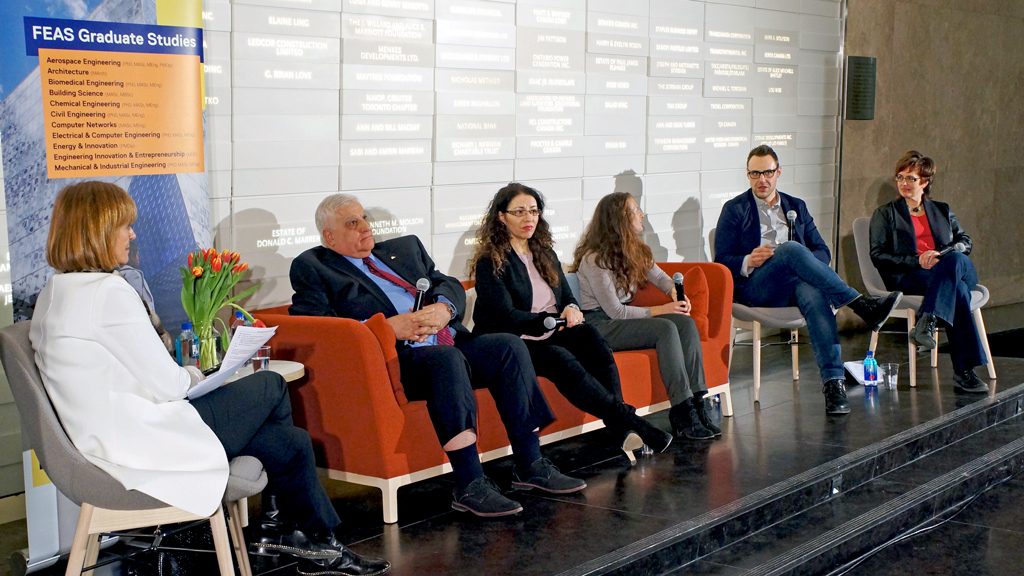Engineers and architects are busy these days. Sometimes too busy.
Both professions often carry heavy workloads that can lead to employee burnout.
“The beauty of the profession we have all chosen…really gets lost when you are overwhelmed with anxiety, depression,” said Jessica Shifman, an associate with Diamond Schmitt Architects, a panellist at a seminar titled Engineering Wellness held at Ryerson University in downtown Toronto recently.
Shifman said among a number of health and wellness initiatives at Diamond Schmitt is one that has staff surveys and small group sessions to address issues to improve the work environment.
The architect was one of five panellists addressing stress and coping strategies. It was moderated by former broadcaster Valerie Pringle.
Panellist Julia Barrasso, a contract employee at Metrolinx, said beyond traditional wellness programs such as meditation, smoke cessation and support groups such as Weight Watchers, are initiatives like mental health first aid, which helps employees identify the symptoms of mental health issues that could lead to a crisis.
Tom Murad, who heads the Siemens Canada Engineering and Technology Academy, said the pressure to succeed can be a big obstacle to wellness for young people in the profession.
“We are setting the bar high on expectations…and it can be impossible to meet,” he stated.
He said engineering schools are “very different” now than when he was in school about 40 years ago. Curriculums today emphasize “the science (theory)” of engineering; in his time practical experience played a bigger role.
Murad told the audience of mostly engineering and architectural grad students that it is OK to make mistakes on the job. Many students wrestle with the fear of failure and it can be self-defeating.
Jason McFadden, of Logit Al, echoed Murad’s comments, adding accepting failure as a part of learning, better equips employees to move on.
But Lois Didyk, a community mental health counsellor with the Toronto East Health Network, said while mistakes “are expected” and accepted from students in the field of social work, her son was under pressure not to screw up during his engineering internship because mistakes could be costly.
Shifman said changing corporate culture to encourage health and wellness should stem from leadership. “If at the very top the priority is the mental health of our students or our staff, it does trickle down to our managers,” she said. “If someone is having trouble it creates a safe place for them to come forward.”
But employers aren’t mind readers. If you need to address a problem, “organize your thoughts” and be “very specific with your needs” before approaching your boss, advised Shifman, who recalls early times in her career when job responsibilities could be daunting and discussing “experience gaps” with her boss was important.
It is also important that employers listen to their workers to help guide them but also to learn from them.
“They (employees) have a lot to teach employers about how their business is going,” she said.
While working in isolation can stunt employee productivity/creativity, a traditional brainstorming strategy used by architectural firms is the design charrette, a collaborative effort to address a project design, she added. It can also create an atmosphere of camaraderie.
Murad told students not to get so wrapped up in work or school that they ignore other aspects of their lives.
“There is no book to tell you how to do it. It’s your life, it is your career, your family, your health,” he said, noting he regrets times in his life when he put work above all else in his life.
Shifman said the panel discussion on wellness wouldn’t have happened when she was studying architecture.
“I am happy to see people are starting to talk about it. Hopefully, we can start to enjoy the real reason why we are doing what we are doing (for a living),” she said.
Barrasso said she sees more employers taking on “a greater social responsibility” to ensure their employees are well within and outside the workplace.
“They realize employees are their most valuable asset and that they have to keep them healthy from a mental and a physical perspective,” she said.











Recent Comments